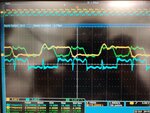tarunkumartars
Newbie level 5
Hello ,
I have two signal yellow and green which i'm doing an xor operation with both and now i get blue signal as an output but the problem is it has a spikes as you can see in every half period. could someone help me in removing that or any ideas?

P.S i'm just playing with gates and i wanted to see if the online simulation and theoretical results matches with my hardware setup which aren't matching. And here the BLUE signal is my final output
thank you
I have two signal yellow and green which i'm doing an xor operation with both and now i get blue signal as an output but the problem is it has a spikes as you can see in every half period. could someone help me in removing that or any ideas?

P.S i'm just playing with gates and i wanted to see if the online simulation and theoretical results matches with my hardware setup which aren't matching. And here the BLUE signal is my final output
thank you